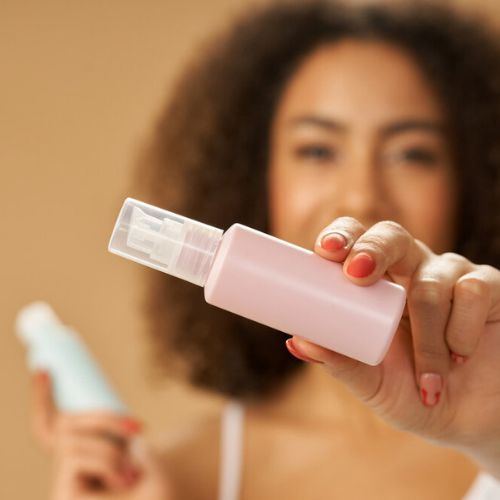Dealing with stringy curly hair can be a real challenge, often leading to frustration when you struggle to achieve the look you desire. The root cause of this issue can be elusive, leaving you uncertain about how to address it.
This common hair concern is typically triggered by several factors, including dryness, extensive damage such as split ends and structural cracks, the use of certain hairstyling products, drying alcohols, and frequent thermal styling.
To provide a comprehensive understanding of this problem, I’ve collaborated with a friend who is an expert in hair science and holds a Ph.D. in Chemistry. Together, we will delve into the scientific aspects of stringy curls. Our goal is to help you pinpoint the specific causes in your case and offer practical solutions to revive your hair, bringing back its natural beauty and health.
Understanding the Unique Characteristics and Care of Curly Hair
With its distinct structural features, curly hair stands apart from other hair types, necessitating a tailored approach to hair care.
Hair types vary extensively, ranging from straight to curly and wavy hair and extending to extremely coily or kinky textures. This diversity in curl patterns is not just a matter of style but a genetic trait determined by the specific characteristics of the hair’s cortex and medulla, which are key internal structures of the hair fiber.
Those with curly hair often aspire to achieve consistently well-defined, healthy curls, yet this goal can be elusive. To nurture and maintain such curls, a specialized daily hair care routine is essential, addressing the unique needs of curly hair type.
Tackling My Stringy Curly Hair
Dealing with hair that becomes unruly and loses its texture can be frustrating, particularly when your bouncy curls transform into a lifeless, stringy mess as the day progresses.
This problem often persists despite numerous attempts with various products and techniques, making the battle against stringy curls seem endless. As someone who has personally experienced this issue, I understand how disheartening it can be. A closer look at the accompanying photos below reveals the stringy ends that refused to blend with the rest of my curls. Additionally, my curls had become loose, lacked luster, and lost their natural curl pattern.
This experience is not uncommon, and in the following sections, we’ll explore effective strategies to overcome the challenge of stringy curly hair, aiming to restore your curls’ vibrancy and definition.


What Causes Stringy Curly Hair?
Stringy curly hair, often appearing limp and devoid of its natural body, bounce, and vibrancy, can be caused by various factors. This section will explore five common causes and provide effective solutions to help you manage and rejuvenate your curls.
Cause #1: Dryness
Maintaining hair’s health, shine, and beauty largely depends on its water content. Our hair is primarily composed of keratin protein, which is exceptionally efficient at absorbing moisture from the surrounding environment.
The level of water in hair varies based on its physical condition and protein content. Additionally, environmental humidity plays a significant role in influencing hair hydration.
Scientific research has shown that harsh chemical treatments, such as perms, relaxers, and bleaching, can severely damage hair, leaving it dry, brittle, and inflexible. These treatments often result in protein loss, leading to increased porosity in the hair. This heightened porosity means the hair has larger pores, which causes it to lose moisture more rapidly, resulting in dryer strands.
A similar effect is observed with high-temperature thermal treatments. The application of heat reduces the hair’s moisture content, leading to brittle and fragile strands that are difficult to manage. This often results in hair becoming stringy, unruly, and frizzy.
Solutions for Combating Dryness
1) Prioritize Hair Health: Limiting excessive and repeated use of harsh chemical treatments is crucial to maintaining healthy hair. These treatments can strip your hair of its natural oils and proteins, leading to dryness and damage.
2) Choose the Right Shampoo: Opt for sulfate-free shampoo. Sulfates, commonly found in many shampoos, can exacerbate hair dryness. Sulfate-free options are gentler on the hair, helping to retain its natural moisture.
3) Use Effective Conditioners: Incorporate rinse-off conditioners that contain cationic conditioning agents and emollients into your hair care routine. These ingredients are essential for managing curly hair.
Key cationic agents to look for include:
- Stearamidopropyl dimethylamine
- Behentrimonium chloride
- Behentrimonium methosulfate
- Cetrimonium chloride
These components are crucial for aligning hair cuticles, reducing fiber-to-fiber friction, and facilitating smooth combing. By using conditioners with these ingredients, you can significantly improve the manageability and appearance of your curly hair.
4) Incorporate Oils and Butters: Oils and butters are essential for maintaining hair health, providing necessary lubrication and softness. Natural oils and butters are highly sought after for their ability to enhance hair quality. Some oils are even known to reduce protein loss from hair, which is crucial for maintaining hair strength and elasticity.
5) Regular Deep Conditioning Treatments: For dry hair, it’s important to apply a nourishing deep conditioner at least once a week, leaving it on for 20-30 minutes. To enhance the effectiveness of these treatments, consider using a hooded dryer or a heat cap. These tools help in faster absorption and deposition of conditioning agents into the hair strands, deeply nourishing and revitalizing dry, curly hair.
Cause #2: Damage from Split Ends and Structural Cracks
Daily, our hair endures various types of physical and chemical stresses. Frequent combing, exposure to extreme temperatures, and undergoing multiple chemical treatments can significantly damage your hair. Additionally, harsh weather conditions can amplify this harm.
These factors contribute to problems like frizz, split ends, cuticle abrasion, and overall difficulty in managing hair. A unique characteristic of curly hair is its inconsistency in diameter along the shaft. This unevenness renders curly hair more fragile at its curves, increasing its susceptibility to breakage.
Moreover, high humidity levels can intensify the issues in already damaged hair strands, making them even more prone to deterioration.
Solution for Split Ends and Structural Cracks in Curly Hair
Addressing the damage caused by split ends and structural cracks is crucial for maintaining the health and beauty of curly hair. Here are effective strategies to combat these issues:
- Regular Trimming: Regularly trimming your hair helps remove split ends and prevent them from traveling up the hair shaft. Aim to get a trim every 6-8 weeks, depending on your hair’s condition.
- Gentle Handling: Minimize damage from physical stress by being gentle when combing or styling your hair. Use a wide-tooth comb or detangling brush with wet hair, and be gentle. Never rush through the process.
- Heat Protection: Limit the use of heat styling tools. When using them, always apply a heat protectant spray to minimize damage.
- Chemical Treatment Care: Reduce the frequency of chemical treatments, such as coloring, perming, or straightening. If you use these treatments, ensure your hair is healthy beforehand, and always follow up with deep conditioning treatments.
- Deep Conditioning: Incorporate deep conditioning treatments into your hair care routine. Look for products rich in proteins and moisturizing agents to repair and strengthen the hair structure. Use these treatments regularly, especially after exposure to harsh weather conditions or chemical processes.
- Humidity Control: Manage humidity effects on frizzy hair with anti-frizz products or natural oils. These products can create a barrier to protect your hair from excess moisture in the air, reducing frizz and further damage.
- Protein Treatments: Incorporating protein treatments into your hair care routine can be highly beneficial, especially for hair weakened by structural damage. These treatments work by replenishing the keratin protein in your hair, which is often lost due to damage. They help to strengthen the hair shaft, reduce breakage, and improve overall texture. Using protein treatments judiciously is important, as overuse can lead to hair stiffness. Aim for a balance between protein and moisture treatments to maintain the health and elasticity of your curls.
Cause #3: Effects of Hairstyling Products
Many of us depend on various hair styling products to enhance and maintain our curly hairstyles. The right products can significantly ease the styling process, whether you’re aiming for smooth, well-defined curls, beachy waves, or any other style.
These styling or fixative products often contain hair-fixing polymers, typically large synthetic molecules. As these polymers settle on your hair, they create a coating that helps set and maintain your desired style after drying.
However, a downside to these polymers is their tendency to adhere to hair fibers, blocking the essential penetration of water molecules. This leads to dry, frizzy, and stringy hair.
Over time, the polymer coating can accumulate, making curls feel gummy and altering their natural shape. Excessive use of these products can reduce the diameter of your curls, resulting in thin, stringy hair.
Solution: Addressing Hairstyling Products
To revive the natural texture of curly hair, it’s essential to remove the polymeric additives often found in styling products.
1) Use a Clarifying Shampoo: Start by washing your hair with a clarifying anti-residue shampoo. This type of shampoo is specially formulated to effectively remove polymer buildup and other residues from your hair.
2) Apply a Gentle Leave-in Conditioner: After shampooing, use a light leave-in conditioner that does not contain any polymeric ingredients. This step will help restore moisture and softness to your hair without adding any heavy or obstructive substances.
3) Experiment with Different Products: Finding the ideal hair styling product for your specific type of curly hair may require some trial and error. Experiment with various formulations to find one that complements your curl pattern without contributing to stringiness or buildup. This personalized approach is key to maintaining the health and beauty of your curls.
Cause #4: The Impact of Drying Alcohols
In hair care products, various formulations include alcohols as solvents or moisturizers. Glycerin and propylene glycol are common examples of such substances.
These substances, known as humectants, are designed to deliver water molecules to the hair. However, an excessive amount can lead to an overabundance of moisture, resulting in frizzy and stringy curly hair.
Other types of drying alcohols include ethyl alcohol, isopropyl alcohol, and butyl alcohol. These are often used as solvents in hair care products, particularly in styling mousses and hairsprays. They are referred to as ‘drying agents’ due to their ability to speed up the drying time of hair styling products.
Restoring Curly Hair Affected by Drying Alcohols
1) Reduce Exposure to Drying Alcohols: To counteract the effects of drying alcohols, minimizing your hair’s exposure to these substances is important. Alongside this, regularly using a moisturizer is essential to restore and maintain the optimal water level in your hair.
2) Choose the Right Humectants and Emollients: The correct balance of humectants and emollients is crucial for this process. Instead of relying on traditional humectants like glycerin or propylene glycol, consider using novel humectants such as Alpha hydroxy acids (e.g., lactic acid or its salts). These innovative humectants can more effectively maintain your hair’s moisture balance.
3) Opt for Beet Sugar-Derived Betaines: Beet sugar-derived betaines have shown superior effectiveness in improving hair’s moisture levels and combating dryness. Incorporating products that contain these betaines can significantly benefit the health and appearance of your curly hair, especially if it has been affected by the use of drying alcohols.
Cause #5: The Effects of Heat Styling: Blow Drying and Flat Ironing
Blow drying and flat ironing are popular methods for styling hair. However, these techniques expose hair to high levels of heat, which can lead to cumulative damage over time.
On a microscopic scale, it has been discovered that the intense heat causes steam formation within the hair shafts, leading to chipping and damage. When water molecules inside the hair evaporate under such extreme conditions, it can cause localized ruptures within the hair structure.
Frequent use of these heat-styling tools can result in severe dryness, potentially causing permanent damage to the hair. This damage often manifests as a loss of natural shine and texture and can even alter the hair’s natural curl pattern.
Restoring Hair Affected by Thermal Styling
1) Use Thermal Protectors: Before engaging in any heat styling treatment, protecting your hair from extreme temperatures is essential. Applying a thermal protector can safeguard your locks and ensure optimal results from the styling process.
2) Leverage the Benefits of Silicones: Silicones are renowned for their exceptional thermal stability, making them capable of withstanding intense heat. They have also been proven to protect hair and control damage caused by thermal styling tools. Including silicone-based products in your hair care regimen can provide an effective shield against heat damage.
3) Natural Oils and Butters as Alternatives: If you prefer to avoid silicone-based products, natural oils or butters are a viable option. Ingredients like sunflower oil, sesame seed oil, and shea butter have high smoke points, allowing them to endure higher temperatures without breaking down. Thermal protector formulations that include these oils are often more effective due to their emulsion system. When applying these protectors, ensure they are distributed evenly throughout your hair to provide comprehensive protection for every strand.
Cause #6: Stringy Curly Hair Due to Hard Water
Hard water, which contains high levels of minerals like calcium and magnesium, can be a significant contributor to stringy curly hair. These minerals tend to build up on the hair, leading to a range of issues.
They can weigh down curls, making them appear limp and stringy. Additionally, hard water can disrupt the natural pH balance of the hair and scalp, leading to reduced moisture retention. This disruption often results in dry, brittle hair that lacks definition and vitality.
Solution: Addressing Hard Water’s Impact on Curly Hair
1) Water Softening Solutions: Consider installing a water softener in your home to combat the effects of hard water. Water softeners remove excess minerals, providing gentler, kinder water to your hair.
2) Chelating Shampoos: Use chelating shampoos monthly. These shampoos are specially formulated to remove mineral build-up from the hair, restoring its natural shine and bounce.
3) Apple Cider Vinegar Rinses: After a good cleanse on wash day, rinse your hair with apple cider vinegar and water. This can help to balance the pH levels of your scalp and hair, removing mineral deposits and restoring moisture.
4) Deep Conditioning Treatments: Regular deep conditioning can counteract the drying effects of hard water. Look for conditioners rich in moisturizing ingredients to rejuvenate and hydrate your curls.
5) Filtering Shower Head: Installing a filtering shower head can also help. These shower heads filter out many of the minerals found in hard water, reducing their impact on your hair.
Summary: Managing Curly Hair and Overcoming Stringy Curls
For those with curly hair, stringy curls can be a common and frustrating issue. However, there’s a simple and effective solution to this challenge. The key to achieving and maintaining beautiful curls lies primarily in addressing dryness, the main culprit behind unruly hair.
You can significantly improve manageability and styling ease by implementing proper conditioning routines and ensuring that your hair is well-moisturized. This approach not only enhances the appearance of your curls but also promotes the overall health of your hair.















